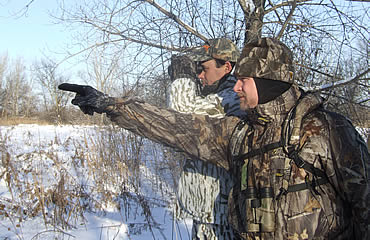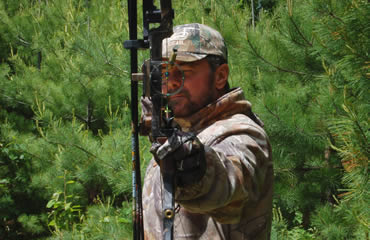Cold-weather bowhunting requires extra practice.
When the 10-pointer with noticeable kickers circled behind me, it was like a scene from a Michael Sieve painting — real but surreal. All I had to do was draw, aim and release. But for some reason, I couldn’t get to full draw that day. Back then, I could easily draw a bow set at 75 pounds, so with the buck preoccupied by pockmarks in the snow, I tried to draw again. My previously smooth-as-butter, 70-pound-pull McPherson stubbornly refused. I never got a third chance, because the buck finally noticed my movement and bolted with a series of snorts.
That deer should have been mine, but my first crack at a big buck in bitter cold temperatures ended with no crack at all, though the humbling experience was educational. That’s the story with many bowhunters’ first frigid encounters.
Dejected, I examined the bow. No problem with the limb pockets, nothing wrong with the cabling, string and serving. So I tried to draw one more time, just in case. The bow wouldn’t budge. With a sudden flurry of snowflakes swirling around me, I remember wondering how it could possibly snow with the temperature being so frigid. In fact, it was so bitter that when I blinked, I couldn’t unblink. Now that’s what I call blinding snow!
When I removed a glove to pry my eyes open, my finger tips turned blue immediately. Can you spell w-i-n-d-c-h-i-l-l? How about b-r-u-t-a-l? No doubt about it, when Old Man Winter paints the landscape with his inimitable artistry, ordinary tasks become a dogfight. That goes double for bowhunters.
It’s no mystery why things go wrong; it’s just Survival 101. Because core organs require a rich blood supply at the expense of fingers, toes, arms and legs, we compensate by adding extra layers of clothing that make the uncomplicated task of drawing a bow complicated. And that’s only the beginning.
Frigid conditions take their toll on shooting form, too. What flies true in October often misses the mark in December and January. When water turns to ice, so do the back muscles and shoulders of many a bowhunter. How much? Expect about a 17 percent loss in body strength.
Dead-eye shooting under these conditions is tough, but it’s venison stew for me now. I live in a Minnesota city that prompted Mark Twain to quip, “The coldest winter I ever spent was a summer in Duluth.” I’ve bowhunted a lot when it’s too cold to go bowhunting. If you’re not afraid to get a little chilled, here’s some stone cold advice on how to be a stone cold shooter.
 NOT SO FAST
NOT SO FAST
An unexpected cold snap, especially the first one of the fall, can catch bowhunters off guard, particularly those traveling to the Midwest and Canada from temperate Southern states. But we bowunters are as much to blame as the weather. The biggest problem is that modern hunters are obsessed with arrow speed.
For the most part, arrow speed is a function of how much draw weight you can pull and how far back you can pull your bowstring. While you can increase speed by exchanging a heavier arrow for a lighter one, the temptation to pull more weight than you should is too much for many to resist. It’s like placing a juicy steak in front of an untrained dog and commanding him to “Stay!”
A plummeting thermometer saps the human body’s strength dramatically, making a bow that pulls comfortably when it’s 70 degrees become immovable when the shooter is cold. Sports medicine research on muscle power suggests the reduction is proportionate to drops in ambient temperature below freezing. Extrapolating for the many variables applicable to archery, bowhunters can expect to lose anywhere from 5 to 10 pounds from their normal draw ability.
SHORTCAKE SETUP
An equally common cold-weather mistake is using a bow with a longer draw length than you should. Back when I converted from a recurve to a compound, I shot a 29-inch model. It was way too long. I have been shooting a 27-inch bow for the past 12 years, and sometimes I reduce it to 261⁄2 inches. Shooting a bow that draws too long is just as costly as shooting a bow with too much resistance. All factors being equal, you can shoot more accurately with a slightly too-short bow than one that’s slightly too long.
Shortening up might seem unnecessary for the early season and when Indian summer lingers, but a tight draw will pay more dividends than a loose draw, hands down.
Remember, your draw length shortens with each layer of extra clothing. Simply put, extra clothing restricts movement, and that reduces your natural draw length. Most of us seem to know this instinctively, causing us to don heavy outer garments that are loose-fitting. Unfortunately, this only magnifies the curse of being over-drawn.
With cold-weather clothing getting in the way, you need to learn what it feels like to be tight — upright and compact — at full draw. Naturally, if the elbow of your bow arm is bent slightly, you have a good foundation. A left bent arm assures a locked shoulder socket, which prevents “reaching.” Those who shoot bows that are too long will reach because they have to. Those who have shot recurves will reach because it’s habit.
Coincidentally, if you happen to be in the market for a new bow, here’s how to tell if it truly fits for all kinds of bowhunting: When you come to full draw, have someone observe how your nose makes contact with your bowstring. If you have to tip your head forward to achieve this portion of a triple anchor point, the bow is simply too long for you, especially if your upper torso leans backward.
I’ve observed accomplished target shooters and bowhunters. One man I know is 6 feet 1 inch tall, yet he shoots a 28-inch bow. I was impressed with how meticulous he was in comparing several bows at the local pro shop before settling on his purchase.
If you shoot with a string loop, you can adjust your draw length as the season progresses. For warm weather, I shoot with a 5⁄8-inch loop (distance from bowstring to back of loop). When it starts to get cold, I reduce it to 3⁄8 inches. That extra quarter-inch makes a significant difference.
 OUT IN THE COLD
OUT IN THE COLD
Being properly fit and outfitted with a well-tuned bow is just the beginning of this journey. A few critical adjustments are still necessary to become a cold-blooded bowhunter. One is staying loose physically.
International Archery Federation (FITA) research reveals that half of the world’s archers eventually suffer a debilitating shoulder injury during their careers. Strains, sprains and tears usually result from use and abuse of the rotator cuff. Prevention is the best medicine, and the best prevention is conditioning. It starts and ends with keeping loose while hunting. Shoulder shrugs and “windmills” are an absolute must. Be sure to scour the immediate vicinity for deer before making any such movements.
Extra clothing adds bulk and compromises bowstring clearance. This often causes arrows to impact left of the intended target (right for lefties). One trick is shooting with a slightly open stance to increase the triangle created by your bow arm, chest and bowstring. Simply slide your left foot (again for right-handers) to the left.
You can also modify shooting form to create extra clearance. Lean forward, stick out your butt and shoot away from your upper body. Of course you should practice these maneuvers prior to hunting. Also use a smartly designed safety harness. Pick one with adjustable shoulder straps that compress the chest area.
Never take your anchor point for granted, especially during the late season. The simple addition of a stocking cap, bomber, ear muffs, neck gaiter or balaclava might prevent frostbite, but arrow flight will be affected. Once again, expect your point-of-impact to shift left (since your release hand moves to the right and away from your face).
Savvy bowhunters practice with their late-season clothing and adjust sight pins accordingly. But that assumes every hunt will take place at the same elevation with the same clothing. Perhaps a better alternative is adopting a quasi-floating anchor point and adding a kisser button to the bowstring.
These days, a compound bow with a mechanical release aid is the combination of choice. The simple act of adding a glove can make triggering a release a fickle proposition. The main reason is the glove changes the distance from your release aid to your bowstring, which alters your anchor point.
In an experiment to determine how critical release-length adjustment is, I compared arrow groups shot with two Scott Archery releases, one a quarter-inch longer than the other. What a difference. If you carry a backup release (and I recommend you do) make sure the length adjustment is identical to your primary release.
In addition, make sure you use the same setting for buckle strap models (which I prefer) and use a permanent marker to ensure consistent length on Velcro-strap releases. Finally, make sure you practice shooting with a glove before you hunt with it.
All that said, what if you continually miss left or right of your intended target? It could be your bow hand. Hand torque is magnified with excessive grip contact, one reason so many new bows feature thin grips. Adding a glove or mitten to your bow hand increases the potential for torque, and the larger the glove or mitten, the more difficult it becomes to achieve an accurate, repeatable grip.
Bow grip is a complex subject, but you should strive to cradle your bow exactly the same way every time. I add a strip of non-skid tape (such as Sure-Step) to the throat of my bow grip, because this helps snuggle a glove onto the grip without any slippage.
Everyone can become an Ice Man shooter, but it takes thought and practice. My system works for me, and it will work for you, too.
– Jeff Murray is no longer with us, but his timeless writing and excellent advice lives on.
Read Recent Articles:
• Right Time, Right Buck: Weather and an empty stomach get the best of this old warrior.
• Old White Foot: Four-year hunt ends in a cloud of smoke ... and a flood of emotions.
• Illinois’ Icicle Buck: Monsters like this aren’t supposed to be around in the second season.
This article was published in the Winter 2009 edition of Buckmasters Whitetail Magazine. Subscribe today to have Buckmasters delivered to your home.